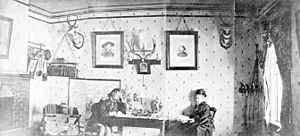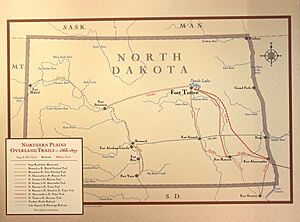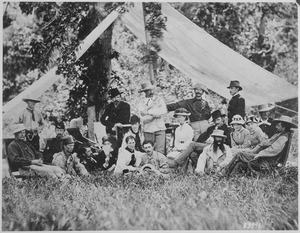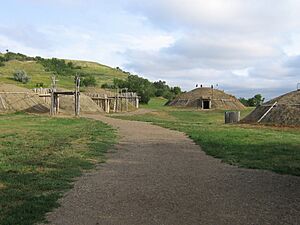Fort Abraham Lincoln facts for kids
Quick facts for kids Fort Abraham Lincoln State Park |
|
|---|---|

Reproduction of Custer's House
|
|
| Lua error in Module:Location_map at line 420: attempt to index field 'wikibase' (a nil value). | |
| Location | Morton County, North Dakota, United States |
| Nearest city | Bismarck, North Dakota |
| Area | 836.47 acres (338.51 ha) |
| Elevation | 1,700 ft (520 m) |
| Established | 1907 |
| Administered by | North Dakota Parks and Recreation Department |
| Designation | North Dakota state park |
| Named for | President Abraham Lincoln |
Fort Abraham Lincoln State Park is a fun place to visit in North Dakota, about 7 miles (11 km) south of Mandan, North Dakota. This park is special because it has a recreated Mandan Indian village called On-A-Slant. You can also see reconstructed military buildings, including the famous Custer House. It's a great spot to learn about history!
Contents
Exploring the Park's Past
The history of Fort Abraham Lincoln State Park goes back a long time. It tells stories of Native Americans and soldiers who lived here.
Mandan Village: A Home by the Rivers
Around 1575, the Mandan Indian tribe built a village where the Missouri River and Heart River meet. They lived in special earth lodges. The Mandan people were good at hunting bison and growing crops. This helped their community grow strong. Sadly, about 200 years later, many Mandan people died from a disease called smallpox. The survivors then moved north to find new homes.
Fort McKeen Becomes Fort Abraham Lincoln
In June 1872, a military post was built in the same spot where the Mandan village once stood. It was first called Fort McKeen. Soldiers from the 6th US Infantry built it. On November 19, 1872, the fort's name changed to Fort Abraham Lincoln. It grew bigger to include a cavalry post for many soldiers.
The fort had 78 wooden buildings! These included a post office, barracks for soldiers, officer's homes, stables for horses, a hospital, and even a bakery. Water was brought from the Missouri River, and wood was supplied for fires. In 1873, the 7th Cavalry moved to the fort. Their job was to help the Northern Pacific Railway expand. The first commander of the expanded fort was Lieutenant Colonel George A. Custer. He stayed in charge until 1876.
The Fort's Final Years and Becoming a Park
In 1876, soldiers left the fort to fight in the Great Sioux War of 1876. This led to Custer's defeat at the Battle of the Little Bighorn. Custer and many of his soldiers did not return to Fort Lincoln. The fort was left empty in 1891 after the railroad was finished. A year later, local people took apart the fort buildings for their wood and nails.
In 1907, President Theodore Roosevelt made the land into Fort Abraham Lincoln State Park. Later, in 1934, the Civilian Conservation Corps helped build a visitor center, shelters, and roads. They also rebuilt military blockhouses and recreated Mandan earth lodges. In 1989, a copy of Custer's house was built in the park. This was for North Dakota's 100th birthday celebration!
What You Can See at the Park
Fort Abraham Lincoln State Park has many interesting things to explore.
On-A-Slant Indian Village: A Look at Mandan Life
The On-A-Slant Mandan Village was built in the late 1500s. It was home to the Mandan tribe until about 1781. The Mandan people had many villages along the Missouri River. On-A-Slant was the southernmost village. It had about 86 earth lodges and around 1,000 to 1,500 people lived there. The village was built on ground that sloped towards the river, which is how it got its name. It had a ditch and a fence (palisade) to protect its food and trade goods.
Mandan women built the earth lodges. They used cottonwood logs for the frame. Then they covered it with willow branches, grass, and earth. These thick walls kept the lodges warm in winter and cool in summer. A hole in the roof let out smoke from the fire and let in sunlight. Each lodge housed about ten to fifteen family members. The Mandan people were good farmers and hunters. They also traded pottery and animal skins. In 1781, a smallpox sickness killed most of the villagers. The remaining Mandan moved north to join the Hidatsa tribe.
Historic Fort Lincoln and the Custer House

Lieutenant Colonel George Armstrong Custer and his wife, Libbie, lived at Fort Abraham Lincoln from 1873 until Custer died in 1876. About 500 soldiers were also stationed there. Custer's first home burned down in 1874. Today, a copy of his house and seven other main fort buildings have been rebuilt. These include a barracks, a theater, a stable, and blockhouses.
Five Nations Art Gallery: Celebrating Native American Art
The Five Nations Art Gallery is a special art store. It is part of the Fort Abraham Lincoln Foundation. This group works to keep the history of Fort Lincoln alive. The gallery shows art from the five Indian nations of the Northern Plains. You can find paintings, jewelry, sculptures, and beadwork made by local artists. They also have painted buffalo skins and local quilts.
The gallery is in the old Northern Pacific Railway station in Mandan. "Five Nations" refers to the five main groups of Native American tribes in North Dakota. These include the Anishinaabe (Chippewa and Métis), Mandan, Hidatsa, Arikara, and Lakota tribes.
Fun Things to Do at the Park
Fort Abraham Lincoln State Park offers many activities for visitors.

Guided Tours and Museum Visits
You can take living history tours of the Custer House. Guides dressed as people from 1875 will show you around. There are also tours of the On-A-Slant Village. These tours teach you about Mandan culture and their earth lodges. The park has a museum where you can learn even more about the village, Fort Abraham Lincoln, and the park's history. You can also visit the gift shop and coffee shop.
Outdoor Adventures and Entertainment
During the summer, you can watch melodramas (plays) performed by the guides. Some of these plays were even performed at Fort Lincoln in the 1870s! The park has 95 campsites and two sleeping cabins if you want to stay overnight. You can also go horseback riding, hiking, or fishing. There are playgrounds for kids too.
Famous People from the Park's Past
Some important people were connected to this historic area.
- Sheheke: A Mandan tribal chief born here around 1766. He traveled with Lewis and Clark to Washington D.C. in 1806.
- Mato-tope: Another Mandan tribal chief who grew up here. Famous artists painted his picture.
- Frank L. Anders: Born here in 1875, he received the Medal of Honor and became a well-known businessman.
See also
 In Spanish: Fuerte Abraham Lincoln para niños
In Spanish: Fuerte Abraham Lincoln para niños



